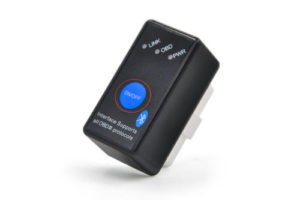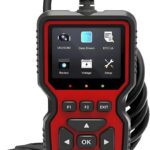For car enthusiasts and everyday drivers alike, understanding your vehicle’s health is becoming increasingly accessible thanks to OBD2 diagnostic tools. At the heart of many of these tools is the ELM327 type OBD2 dongle. This small but powerful device acts as the bridge between your car’s computer and your smartphone, tablet, or laptop, allowing you to read diagnostic codes, monitor performance, and much more. But with a market flooded with options, choosing the right ELM327 OBD2 dongle can be confusing. This guide will help you navigate the choices and select the best adapter for your needs.
Understanding ELM327 OBD2 Adapters
An ELM327 adapter is essentially a communication interface. It plugs into your car’s OBD2 port – usually located under the dashboard – and uses the ELM327 command set to translate your vehicle’s data into a format that your devices can understand. These adapters connect wirelessly via Bluetooth, Bluetooth LE, or Wi-Fi, or in less common cases, via USB (though USB is not supported by all software, including Car Scanner).
The adapter you choose dictates not only whether you can connect to your car’s systems at all, but also the quality and reliability of that connection. A poor choice can lead to frustration, inaccurate data, or even potential issues with your vehicle’s electronics.
Connection Types: Bluetooth, Bluetooth LE, and Wi-Fi
When selecting an ELM327 OBD2 dongle, the first key consideration is the connection type. This primarily depends on the operating system of your smartphone or tablet. Adapters are generally categorized by their connection method:
- Wi-Fi: These adapters create their own Wi-Fi network to communicate with your device.
- Bluetooth (Classic): Utilizing older Bluetooth standards (1.x, 2.x, 3.x), these are common and widely compatible with Android devices.
- Bluetooth Low Energy (LE) / Bluetooth 4.0+: Designed for lower power consumption, Bluetooth LE is essential for iOS devices and also works with Android.
- Bluetooth MFi: This is a specific type of classic Bluetooth certified by Apple for use with iPhones and iPads. These are less common and often more expensive due to Apple’s certification requirements.
- USB: While some ELM327 adapters use USB, it’s important to note that wireless options are generally more convenient and widely supported by diagnostic apps.
Choosing for Apple iOS (iPhone/iPad)
Apple’s iOS ecosystem has specific connectivity requirements. iPhones and iPads cannot connect to classic Bluetooth OBD2 adapters due to limitations within the operating system. For iOS devices, your options are:
- Bluetooth LE (4.0 or higher): This is often the recommended choice for iOS. Bluetooth LE adapters offer a good balance of ease of connection, acceptable data transfer speeds, and availability.
- Wi-Fi: Wi-Fi adapters can work with iOS, but they often present a less seamless user experience. Connecting to a Wi-Fi adapter typically means disconnecting from your mobile internet, which can be inconvenient.
- Bluetooth MFi: For the most reliable and fastest connection on iOS, Bluetooth MFi adapters like OBDLink MX+ and vLinker FS are top-tier choices, though they come at a premium price.
Crucially, always verify the Bluetooth version when buying for iOS. Many users mistakenly purchase classic Bluetooth adapters, only to find they are completely incompatible with their iPhones or iPads. This is a fundamental limitation of iOS and not something that can be overcome by different apps or software.
For iOS users seeking a balance of performance and affordability, Bluetooth LE (4.0) ELM327 OBD2 dongles are generally the best recommendation. If you need the absolute best performance and are willing to invest more, consider a Bluetooth MFi adapter. Wi-Fi should typically be avoided for iOS due to potential connectivity hassles.
Choosing for Google Android
Android devices offer more flexibility in terms of connectivity. They support classic Bluetooth, Bluetooth LE, and Wi-Fi ELM327 adapters. However, for Android, classic Bluetooth adapters are often preferred.
- Bluetooth (Classic): These are typically faster than Bluetooth LE on Android and are considered very reliable. The vast majority of Android users opt for classic Bluetooth OBD2 dongles.
- Bluetooth LE (4.0 and above): These will also work with Android, offering compatibility similar to iOS.
- Wi-Fi: Android also supports Wi-Fi OBD2 adapters, but Bluetooth is generally simpler to set up and use.
A minor drawback of classic Bluetooth on Android is potential interference if you have multiple Bluetooth devices connected simultaneously, such as a car multimedia system. However, this is not a common issue for most users.
For Android users, classic Bluetooth ELM327 OBD2 dongles are a solid and recommended choice, offering speed, reliability, and broad compatibility.
Quality Concerns: Good vs. Bad ELM327 Adapters
Beyond connection type, the quality of the ELM327 OBD2 dongle is paramount. Forget outdated notions about specific chip versions or circuit board counts. These are no longer reliable indicators of quality. Counterfeiters have become adept at mimicking these features. Instead, focus on the adapter’s actual performance and reliability.
Think of ELM327 adapters as falling into two categories: “good” and “bad.” A “good” adapter simply works as intended – it reliably connects, transmits data accurately, and doesn’t introduce problems. Unfortunately, the market is saturated with “bad” adapters that suffer from a range of issues.
Problems with “Bad” ELM327 OBD2 Dongles
Using a low-quality ELM327 OBD2 dongle can lead to numerous problems, including:
- Complete Failure to Work: The adapter may simply not connect or power on.
- Unstable Operation: Intermittent connectivity, freezing, spontaneous reboots, or failure under certain conditions (temperature, humidity) are common. An adapter might work one day and fail the next for no apparent reason.
- Incomplete Command Support: “Bad” adapters may falsely claim to support the full ELM327 command set but only implement a subset, limiting functionality.
- Fixed ECU Address: Some are hardcoded to communicate with only a specific ECU address, preventing communication with other control units in your car.
- Data Length Limitations: Restrictions on the length of data requests and responses can hinder comprehensive diagnostics.
- Data Loss: Packets of data can be dropped during transmission, leading to incomplete or corrupted information.
- Data Corruption: Incorrect data transmission can lead to misdiagnosis or, in more serious scenarios, unintended commands being sent to the vehicle’s systems. Imagine accidentally sending an erase command instead of a temperature request!
- Protocol Incompatibility: Limited protocol support means the adapter might work on some cars but not others, even if they are OBD2 compliant.
- On-Board Network Interference: Faulty adapters can flood the car’s network with erroneous data or requests, potentially causing engine roughness or other performance issues by disrupting the ECU’s normal operation.
- Risks During Coding and Service Functions: For advanced users attempting coding or service procedures, a high-quality adapter is essential. Data writing to the ECU demands reliable communication, and a “bad” adapter can lead to failed procedures or, worse, corrupting the ECU’s software.
The overwhelming issue is the sheer number of poor-quality ELM327 OBD2 dongles on the market. It’s possible to purchase multiple adapters and have them all be unreliable.
Recommended ELM327 OBD2 Adapters for Quality and Reliability
Finding a reliable ELM327 OBD2 dongle is crucial. Based on experience and user feedback, here are some recommended adapters, categorized roughly from most expensive to more budget-friendly options:
- OBDLink MX+ with Bluetooth MFi (#ad link): (Around $100 USD). Top-of-the-line, compatible with both iOS and Android, Bluetooth MFi certified for optimal iOS performance.
- OBDLink CX with Bluetooth LE (#ad link): (Around $80-$100 USD). Bluetooth LE, excellent performance, large memory buffer, compatible with iOS and Android.
- vLinker Devices (#ad link): vLinker has emerged as a strong contender, offering various models:
- vLinker MC+ with Bluetooth LE (#ad link): Bluetooth LE, recommended for iOS.
- vLinker FS with Bluetooth MFi (#ad link): Bluetooth MFi, excellent for iOS.
- vLinker MS with Bluetooth MFi: Another Bluetooth MFi option aiming to compete with OBDLink.
- General vLinker Recommendation: MC, MC+, FS, or MS are recommended for iOS. Any vLinker model is generally good for Android. Firmware updates are available from the manufacturer and are recommended to ensure optimal performance.
- Vgate iCar Pro 2S: A newer model that supersedes the iCar Pro BLE, offering improved performance.
- Vgate iCar Pro BLE (#ad link): Features both Bluetooth 2.0 and Bluetooth 4.0, making it compatible with iOS, Android, and Windows. Ensure firmware is updated (version 4.1.02 from 2021/01/08 or later) to address potential issues with CAN Extended addressing, especially for Toyota and BMW vehicles. Firmware updates are available online.
ELM327 OBD2 Adapters to Avoid
To help you steer clear of problematic adapters, here is a list of types and brands to avoid:
- xTool Adapters: These are not ELM327 compatible and only work with xTool’s proprietary software.
- Wired Adapters (USB, COM): Car Scanner and many modern diagnostic apps are designed for wireless adapters.
- “Mini” Adapters: Adapters with “mini” in the name have an extremely high chance of being low quality.
- Extremely Cheap Adapters: Exceptionally low prices are often a red flag for poor quality.
- Adapters with Bluetooth MAC Addresses Starting with 11:22:33 or 00:00:00: These are often indicators of generic, low-quality clones.
- KONNWEI Devices: While previously recommended, KONNWEI adapters have reportedly declined in quality and are prone to data loss.
- “Micro Mechanic” Adapters: Many users report these failing after only a short period of use.
- “THINMI.COM” Adapters: Known for limited ELM327 command support and frequent fake responses.
- KUULAA Brand Adapters.
- Adapters with a Specific Generic Design: Avoid adapters that look like these, as they are frequently of low quality:
In conclusion, choosing the right ELM327 OBD2 dongle requires careful consideration of both connection type and quality. For iOS, Bluetooth LE or Bluetooth MFi are the recommended paths. For Android, classic Bluetooth is a robust option. Investing in a reputable brand and avoiding the “bad” adapter pitfalls will ensure a reliable and valuable car diagnostic experience.
P.S. Please note that links on this page may lead to Amazon.com, and as an Amazon Associate, I may earn from qualifying purchases.

